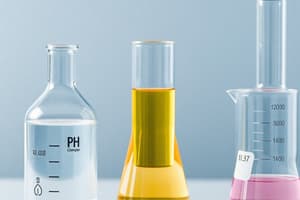Podcast
Questions and Answers
Given that $K_w = 1.0 \times 10^{-14}$ at $25^{\circ}C$, how does an increase in $[H^+]$ affect the $[OH^-]$ concentration, and subsequently, the $pOH$?
Given that $K_w = 1.0 \times 10^{-14}$ at $25^{\circ}C$, how does an increase in $[H^+]$ affect the $[OH^-]$ concentration, and subsequently, the $pOH$?
- An increase in $[H^+]$ causes an increase in $[OH^-]$, leading to a higher $pOH$ value.
- An increase in $[H^+]$ has no effect on $[OH^-]$ or the $pOH$ value because $K_w$ is constant.
- An increase in $[H^+]$ initially decreases $[OH^-]$, but then the system buffers to restore the original $pOH$.
- An increase in $[H^+]$ causes a decrease in $[OH^-]$, leading to a lower $pOH$ value. (correct)
In a solution where the $pH$ is greater than 7 at $25^{\circ}C$, which of the following statements accurately describes the relationship between $[H^+]$ and $[OH^-]$?
In a solution where the $pH$ is greater than 7 at $25^{\circ}C$, which of the following statements accurately describes the relationship between $[H^+]$ and $[OH^-]$?
- The concentration of $[H^+]$ is greater than the concentration of $[OH^-]$, indicating an acidic solution.
- The concentration of $[H^+]$ fluctuates independently of $[OH^-]$, making the $pH$ an unreliable indicator.
- The concentration of $[H^+]$ is equal to the concentration of $[OH^-]$, indicating a neutral solution.
- The concentration of $[H^+]$ is less than the concentration of $[OH^-]$, indicating a basic solution. (correct)
If a solution's $pOH$ is 3.0 at $25^{\circ}C$, what is the $pH$ of the solution, and what does this indicate about the solution's acidity or alkalinity?
If a solution's $pOH$ is 3.0 at $25^{\circ}C$, what is the $pH$ of the solution, and what does this indicate about the solution's acidity or alkalinity?
- The $pH$ cannot be determined with the given information.
- The $pH$ is 3.0, indicating the solution is acidic.
- The $pH$ is 7.0, indicating the solution is neutral.
- The $pH$ is 11.0, indicating the solution is basic. (correct)
Consider two solutions: Solution A has a $pH$ of 4.0, and Solution B has a $pOH$ of 12.0. Which solution is more acidic, and what is the difference in their hydrogen ion concentrations?
Consider two solutions: Solution A has a $pH$ of 4.0, and Solution B has a $pOH$ of 12.0. Which solution is more acidic, and what is the difference in their hydrogen ion concentrations?
How does temperature affect the relationship between $pH$ and $pOH$ in aqueous solutions, and what implications does this have for determining neutrality?
How does temperature affect the relationship between $pH$ and $pOH$ in aqueous solutions, and what implications does this have for determining neutrality?
Flashcards
What is pH?
What is pH?
Measures the acidity of a solution; values range from 0-14.
What is pOH?
What is pOH?
Measures the concentration of hydroxide ions (OH-) in a solution.
What does pH > 7 mean?
What does pH > 7 mean?
pH > 7 indicates that a solution is basic (alkaline).
What does pOH > 7 mean?
What does pOH > 7 mean?
Signup and view all the flashcards
Relationship between pH and pOH
Relationship between pH and pOH
Signup and view all the flashcards
Study Notes
- El pH y el pOH son medidas de la acidez o alcalinidad de una solución acuosa
- Ambos están relacionados mediante una ecuación matemática simple, y su comprensión es fundamental en química y otras disciplinas científicas
pH
- El pH mide la concentración de iones de hidrógeno (H+) en una solución
- Se define como el logaritmo negativo en base 10 de la actividad de los iones de hidrógeno: pH = -log[H+]
- En soluciones diluidas, la actividad se aproxima a la concentración molar
- La escala de pH normalmente va de 0 a 14:
- pH < 7 indica una solución ácida (exceso de H+)
- pH = 7 indica una solución neutra (igual concentración de H+ y OH-)
- pH > 7 indica una solución básica o alcalina (exceso de OH-)
pOH
- El pOH mide la concentración de iones hidróxido (OH-) en una solución
- Se define como el logaritmo negativo en base 10 de la actividad de los iones hidróxido: pOH = -log[OH-]
- Al igual que con el pH, en soluciones diluidas, la actividad se aproxima a la concentración molar
- La escala de pOH también va de 0 a 14, pero la interpretación es inversa al pH:
- pOH < 7 indica una solución básica o alcalina (exceso de OH-)
- pOH = 7 indica una solución neutra (igual concentración de H+ y OH-)
- pOH > 7 indica una solución ácida (exceso de H+)
Relación entre pH y pOH
- En soluciones acuosas, el pH y el pOH están relacionados por la siguiente ecuación: pH + pOH = 14
- Esta relación se deriva del producto iónico del agua (Kw), que a 25°C es 1.0 x 10-14
- Kw = [H+][OH-] = 1.0 x 10-14
- Tomando el logaritmo negativo de ambos lados de la ecuación, se obtiene: -log[H+] - log[OH-] = -log(1.0 x 10-14)
- Simplificando, se llega a: pH + pOH = 14
Comparación de pH y pOH
- Si el pH es mayor que (>):
- pH > pOH: La solución es ácida. Esto se debe a que una mayor concentración de iones de hidrógeno (H+) implica un pH más bajo, mientras que una menor concentración de iones de hidróxido (OH-) implica un pOH más alto. Por lo tanto, si el pH es numéricamente mayor que el pOH, la solución es ácida.
- pH > 7: La solución es básica. Dentro de la escala de pH, cualquier valor mayor a 7 indica una solución básica o alcalina.
- Si el pOH es mayor que (>):
- pOH > pH: La solución es básica. Una mayor concentración de iones de hidróxido (OH-) implica un pOH más bajo, y una menor concentración de iones de hidrógeno (H+) implica un pH más alto. Por lo tanto, si el pOH es numéricamente mayor que el pH, la solución es básica.
- pOH > 7: La solución es ácida. Dentro de la escala de pOH, cualquier valor mayor a 7 indica una solución ácida.
Resumen
- pH > pOH implica una solución ácida, ya que el pH es numéricamente mayor, lo que significa que la concentración de H+ es relativamente alta en comparación con la concentración de OH-
- pOH > pH implica una solución básica, ya que el pOH es numéricamente mayor, lo que significa que la concentración de OH- es relativamente alta en comparación con la concentración de H+
Studying That Suits You
Use AI to generate personalized quizzes and flashcards to suit your learning preferences.



